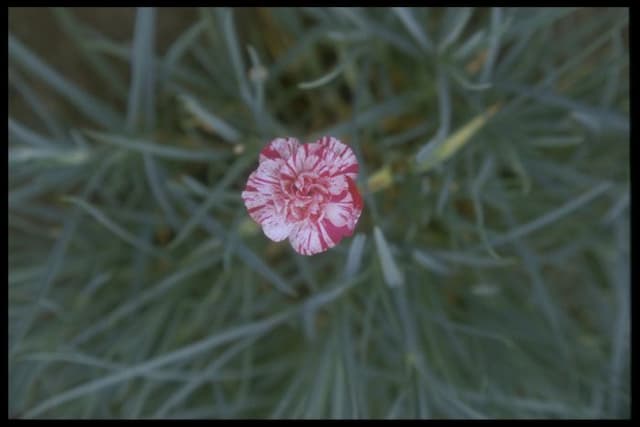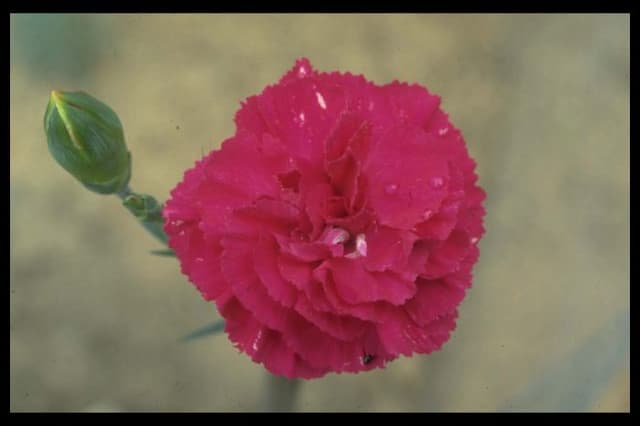Carnation Dianthus 'Marg's Choice' (p)

ABOUT
Dianthus 'Marg's Choice' is a striking plant known for its beautiful flowers and foliage. It typically sports a dense tuft of narrow, slightly greyish-green leaves that form an attractive, low-lying cushion. The leaves are slender and may appear slightly grass-like. This plant is primarily celebrated for its eye-catching blooms, which are what set it apart in the garden. The flowers posses a frilly look as they display a vibrant hue—often a mix of pink, red, or purple shades. Each blossom is elegantly arranged with tightly packed petals that can have subtly serrated edges, giving them a lacy appearance. In addition, these flowers usually boast a distinctive, spicy clove-like fragrance that can be quite strong and appealing. These blooms are carried atop slender, sturdy stems that rise above the foliage, forming an airy cloud of color when the plant is in full bloom. The overall impression of Dianthus 'Marg's Choice' is one of delicate charm and bright, cheerful color, ideal for adding a vibrant touch to any garden setting.
About this plant
 Names
NamesFamily
Caryophyllaceae
Synonyms
Marg's Choice Pink
Common names
Dianthus 'Marg's Choice'
 Toxicity
ToxicityTo humans
Dianthus 'Marg's Choice', commonly known as carnation, is not known to be toxic to humans. There are no common symptoms of poisoning associated with the carnation since it is not considered poisonous. Ingesting parts of the plant typically should not lead to any serious consequences for humans.
To pets
Carnation, the common name for Dianthus 'Marg's Choice', is considered to be mildly toxic to pets, particularly cats and dogs. If ingested, it may cause mild gastrointestinal symptoms such as vomiting or diarrhea. The consequences are generally not severe, but if a pet consumes a large amount of the plant, it is advisable to consult with a veterinarian.
 Characteristics
CharacteristicsLife cycle
Perennials
Foliage type
Evergreen
Color of leaves
Blue-green
Flower color
Pink
Height
1 foot (30 cm)
Spread
1 foot (30 cm)
Plant type
Herb
Hardiness zones
Varies
Native area
Europe
Benefits
 General Benefits
General Benefits- Attracts Pollinators: Dianthus 'Marg's Choice' invites bees and butterflies to the garden, enhancing pollination.
- Low Maintenance: This plant is known for being easy to care for, requiring minimal upkeep once established.
- Drought Tolerance: Once established, it exhibits a degree of drought resistance, making it suitable for drier climates.
- Long Blooming Season: The plant provides a long season of flowers, often from late spring to early fall, offering prolonged periods of visual interest.
- Fragrance: Dianthus 'Marg's Choice' emits a pleasant fragrance, which can add a lovely scent to gardens and outdoor spaces.
- Edging Plant: Its compact growth habit makes it an excellent choice for borders and edging in garden designs.
- Variety of Uses: The plant can be utilized in rock gardens, container plantings, and as ground cover due to its versatility.
- Colorful Blooms: It produces vibrant flowers which can add a splash of color to any garden setting.
- Erosion Control: The dense foliage and mat-forming habit can help to prevent soil erosion on slopes.
- Cold Hardy: Dianthus 'Marg's Choice' is capable of withstanding cooler temperatures, making it suitable for a variety of climates.
 Medical Properties
Medical PropertiesThis plant is not used for medical purposes.
 Air-purifying Qualities
Air-purifying QualitiesThis plant is not specifically known for air purifying qualities.
 Other Uses
Other Uses- Creating Natural Dyes: The petals of Dianthus can be boiled to extract natural pigments for dyeing fabrics or crafting inks, giving a range of colors from pale pink to deep purples depending on concentration.
- Edible Decorations: Petals of Dianthus are edible and can be used as a colorful, spicy addition to salads, desserts, or as an elegant garnish for cocktails and drinks.
- Scented Sachets: Dried petals and leaves have a pleasant fragrance and can be tucked into sachets to freshen drawers or closets.
- Book Pressing: Dianthus flowers are suitable for flower pressing, often used in crafting, such as making bookmarks or decorating greeting cards.
- Culinary Oils and Vinegars: Petals can be infused into oils or vinegars to introduce a subtle flavor and decorative appearance to culinary creations.
- Eco-friendly Confetti: Dried petals serve as biodegradable confetti for celebrations, reducing plastic waste from traditional confetti.
- Candle Making: Incorporating petals into homemade candles to add color and a mild fragrance when the candles burn.
- Soap Crafting: Petals can be used in soap making for exfoliation, visual appeal, and a light natural scent.
- Art Supplies: Flowers and leaves can be used in nature crafts, such as eco-printing, a process that transfers natural pigments and shapes onto paper or fabric.
- Fragrance Pouches for Cars: Petals and leaves can be placed in small pouches to act as a natural car air freshener.
Interesting Facts
 Feng Shui
Feng ShuiThe plant Carnation is not used in Feng Shui practice.
 Zodiac Sign Compitability
Zodiac Sign CompitabilityThe plant Carnation is not used in astrology practice.
 Plant Symbolism
Plant Symbolism- Devotion: The Dianthus flower is often associated with devotion due to its long-lasting nature and the way it blooms year after year, much like an enduring affection.
- Admiration: The bright and vivid colors of the Dianthus 'Marg's Choice' can represent deep admiration for someone, with its hues often indicating heartfelt emotions.
- Dignity: Dianthus flowers stand upright and maintain their form, symbolizing dignity and the strength to stand with grace under pressure.
- Divine Love: In Christian symbolism, Dianthus, sometimes called a "divine flower," is associated with the Virgin Mary, representing pure, unconditional love.
- Boldness: The striking appearance and spicy fragrance of the Dianthus reflect boldness, encouraging one to face life’s challenges with courage.
 Water
WaterFor optimal growth of the carnation 'Marg's Choice', water it thoroughly when the top inch of the soil feels dry to the touch. In general, this may mean watering once or twice a week, but this can vary depending on climate and soil conditions. Provide enough water to moisten the soil evenly, which might be around 1-2 gallons depending on the size of the plant and the pot. Be cautious not to overwater, as carnations do not like soggy conditions. During hot, dry periods, more frequent watering may be necessary, while in cooler weather or when the plant is not actively growing, less water is required.
 Light
LightCarnations, including 'Marg's Choice', thrive in full sun to partial shade. The ideal location would be a spot where the plant receives at least six hours of direct sunlight daily. If you are growing the plant indoors, place it near a south-facing window where it can get ample light. However, be mindful during the peak summer heat; if the sunlight is too intense, provide some afternoon shade to protect the flowers from burning.
 Temperature
TemperatureCarnations such as 'Marg's Choice' prefer moderate temperatures and will grow best when daytime temperatures are between 60-70 degrees Fahrenheit and nighttime temperatures do not drop below 50 degrees Fahrenheit. They can survive minimum temperatures down to approximately 40 degrees Fahrenheit but will not tolerate frosts or prolonged exposure to temperatures below this level. Ensuring good air circulation around plants will also help maintain the appropriate temperature and prevent disease.
 Pruning
PruningPruning carnations like 'Marg's Choice' is important to encourage bushiness, remove dead or faded flowers, and maintain a compact shape. Deadheading spent flowers promptly can also promote continuous blooming. The best time to prune is in early spring before new growth begins. Additionally, after the first killing frost, trim back foliage to an inch or two above the soil to prepare for winter and remove old or diseased parts.
 Cleaning
CleaningAs needed
 Soil
SoilCarnations prefer well-draining, fertile soil with a neutral to slightly alkaline pH between 6.7 and 7.5. A mix of loam, peat, and coarse sand in equal parts can provide the necessary aeration and nutrients. Adding compost can enhance fertility.
 Repotting
RepottingCarnations generally require repotting every one to two years. Oversized pots can lead to soil that stays damp too long, so choosing the right-sized container is important for plant health.
 Humidity & Misting
Humidity & MistingCarnations do best in moderate humidity levels, as too high humidity can encourage fungal diseases like rust or mildew. Average room humidity should suffice, with good air circulation to maintain plant health.
 Suitable locations
Suitable locationsIndoor
Ensure full sun, cool temperatures, and regular feeding.
Outdoor
Plant in full sun, well-draining soil, and protect from harsh winds.
Hardiness zone
3-9 USDA
 Life cycle
Life cycleDianthus 'Marg's Choice', commonly known as Carnation or Pinks, begins its life cycle when seeds are sown in well-draining soil, with germination typically occurring within one to two weeks under optimal conditions. Seedlings emerge and gradually develop into young plants, featuring a rosette of slender leaves at the base. As the plant matures, it develops sturdy stems and a profusion of flowers, often blooming in late spring through early summer, showcasing a range of pink hues with a distinctively fringed or toothed petal edge. After pollination, typically by bees and butterflies, it sets seed, which can be collected for propagation or left to self-sow. During the growing season, Carnations may have multiple blooming periods if deadheaded to encourage new flowers. The plant will eventually enter a period of dormancy in the colder months, reducing its activity before resuming growth in the following spring, completing its perennial life cycle.
 Propogation
PropogationPropogation time
Spring-Early Summer
The Dianthus 'Marg's Choice', commonly known as "pinks," can typically be propagated by cuttings, a popular and straightforward method. As there's no best universal time for propagation, the optimal time for taking cuttings can vary with climate but generally, late spring to early summer is suitable when the plant is actively growing. To propagate by cuttings, choose a healthy, non-flowering stem and cut a 3 to 4-inch segment (7.6 to 10.2 centimeters) just below a node. Remove the bottom leaves to expose the nodes as this is where roots will develop. Dip the cut end into rooting hormone to encourage root growth and insert the cutting into a pot filled with a mix of peat and perlite or sand. Ensure the soil remains moist but not waterlogged and provide indirect light. Roots should develop within a few weeks after which the cutting can be transplanted to a larger pot or directly into the garden.









